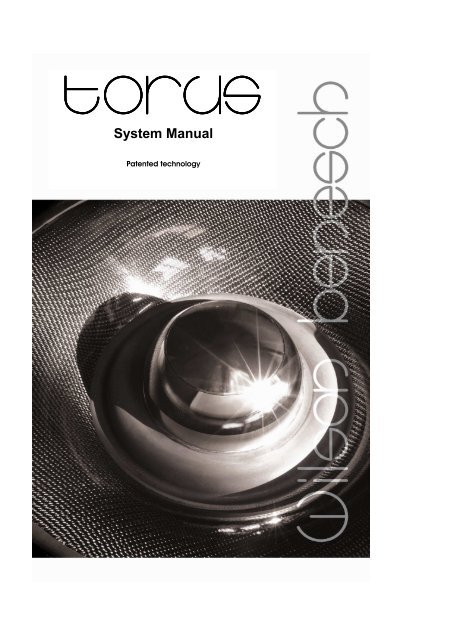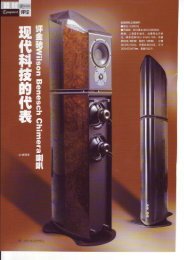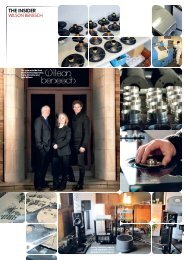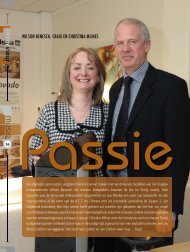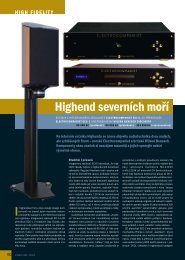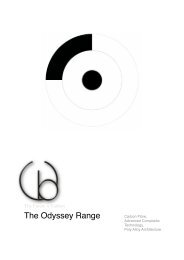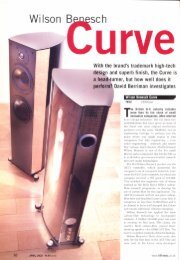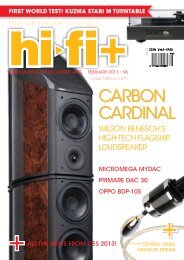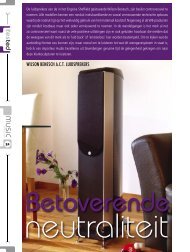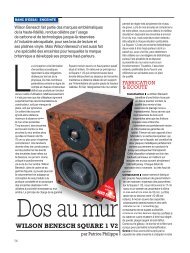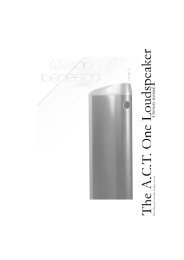Please click here to download the Torus manual - Wilson Benesch
Please click here to download the Torus manual - Wilson Benesch
Please click here to download the Torus manual - Wilson Benesch
You also want an ePaper? Increase the reach of your titles
YUMPU automatically turns print PDFs into web optimized ePapers that Google loves.
����<br />
���� ��������<br />
���� ����<br />
System Manual<br />
Patented technology
WELCOME<br />
Thank you for investing in a <strong>Wilson</strong> <strong>Benesch</strong> product.<br />
The <strong>Torus</strong> Infrasonic Genera<strong>to</strong>r is completely original in thought and execution, and is<br />
manufactured by <strong>Wilson</strong> <strong>Benesch</strong> in Sheffield. The finest materials in <strong>the</strong> world have been<br />
designed in<strong>to</strong> this product, materials technologies that you will not find in any o<strong>the</strong>r audio<br />
product.<br />
This <strong>manual</strong> has been constructed <strong>to</strong> facilitate both ease of installation and long-term use as<br />
well as important safety information and helpful advice. It is strongly advised that you carefully<br />
absorb this before embarking upon <strong>the</strong> installation.<br />
1
WORLD WIDE WARRANTY<br />
In addition <strong>to</strong> any local warranty, <strong>Wilson</strong> <strong>Benesch</strong> offers a 3 year conditional warranty <strong>to</strong> <strong>the</strong> end user.<br />
This is done in collaboration with our distribu<strong>to</strong>rs.<br />
The conditions of this warranty are:<br />
1. That <strong>Wilson</strong> <strong>Benesch</strong> receive <strong>the</strong> necessary registration details from <strong>the</strong> end user.<br />
2. That <strong>the</strong>se details are received within six weeks of purchase.<br />
3. That it is only valid for <strong>the</strong> first owner and that it is not transferable.<br />
4. Nei<strong>the</strong>r transportation, nor any o<strong>the</strong>r costs, nor any risk for removal, transportation and installation of<br />
products is covered by this warranty.<br />
5. That it is limited <strong>to</strong> <strong>the</strong> repair of <strong>the</strong> equipment only.<br />
6. That any claim is accompanied by <strong>the</strong> necessary proof of purchase.<br />
7. That cover does not extend <strong>to</strong> damage caused by faulty or unsuitable ancillary equipment.<br />
8. That <strong>the</strong> serial number has not been altered, deleted, removed or made illegible.<br />
9. That it shall be for a term of 3 years from <strong>the</strong> data of purchase.<br />
10. That <strong>the</strong> product has not been abused or modified in any way.<br />
11. That it was purchased originally from a <strong>Wilson</strong> <strong>Benesch</strong> authorised dealer.<br />
This warranty is offered in good faith and is in addition <strong>to</strong> any statuary rights or existing Warranty that may be<br />
available <strong>to</strong> <strong>the</strong> end user.<br />
Should your <strong>Wilson</strong> <strong>Benesch</strong> <strong>Torus</strong> system exhibit a problem, please contact your dealer who will be able <strong>to</strong> make<br />
<strong>the</strong> necessary arrangements <strong>to</strong> correct it.<br />
SERVICE AFTER WARRANTY<br />
<strong>Please</strong> contact your dealer in <strong>the</strong> first instance before returning <strong>the</strong> product directly <strong>to</strong> us. Should <strong>the</strong> unit need <strong>to</strong><br />
be returned for any reason, all carriage costs will be payable by <strong>the</strong> cus<strong>to</strong>mer. Losses or damage caused during<br />
transit are <strong>the</strong> cus<strong>to</strong>mers’ risk.<br />
How <strong>to</strong> claim repairs under warranty:<br />
Should service be required, please follow <strong>the</strong> following procedure:<br />
1. If <strong>the</strong> equipment is being used in <strong>the</strong> country of purchase, you should contact <strong>the</strong> <strong>Wilson</strong> <strong>Benesch</strong> authorised<br />
dealer from whom <strong>the</strong> equipment was purchased.<br />
2. If <strong>the</strong> equipment is being used outside <strong>the</strong> country of purchase, you should contact <strong>the</strong> <strong>Wilson</strong> <strong>Benesch</strong><br />
national distribu<strong>to</strong>r in <strong>the</strong> country of residence who will advise w<strong>here</strong> <strong>the</strong> equipment can be serviced. You can<br />
call <strong>Wilson</strong> <strong>Benesch</strong> in <strong>the</strong> UK or visit our web site <strong>to</strong> get <strong>the</strong> contact details for your local distribu<strong>to</strong>r. To<br />
validate your warranty, you will need <strong>to</strong> produce this warranty booklet completed and stamped by your dealer<br />
on <strong>the</strong> date of purchase. Alternatively, you will need <strong>the</strong> original sales invoice or o<strong>the</strong>r proof of ownership and<br />
date of purchase.<br />
2
INTRODUCTION<br />
Because These<br />
Don’t Work…..<br />
We Designed Something That Does!<br />
3
So we started <strong>here</strong>!<br />
4
And created this<br />
To do this<br />
Isobaric Tactic ®<br />
5
Benefits of <strong>the</strong> ‘CLAMSHELL’ Design<br />
CLAMSHELL orientation of<br />
Tactic drive unit cancels third<br />
order non-linearity’s.<br />
At 200 Hz and below <strong>the</strong><br />
composite diaphragm is coupled<br />
and can be seen as a solid,<br />
super lightweight structure.<br />
For a given limit of low frequency,<br />
<strong>the</strong> enclosure volume required by<br />
<strong>the</strong> Isobaric is half that of <strong>the</strong><br />
single driver, conventional option.<br />
The composite diaphragm<br />
defeats <strong>the</strong> communication of<br />
internal reflections and o<strong>the</strong>r<br />
dis<strong>to</strong>rtion that is unwanted<br />
energy acting against <strong>the</strong> music.<br />
6
Which led <strong>to</strong> The Bishop<br />
Reference (1999)<br />
8 Mo<strong>to</strong>rs driving 8 cones <strong>to</strong> achieve dynamics<br />
Five years later a feasibility study grew out<br />
of this work that led <strong>to</strong> this<br />
7
Which <strong>the</strong>n led <strong>to</strong> <strong>the</strong>se ideas<br />
That enabled this!<br />
8
WILSON BENESCH DESIGN PHILOSOPHY AND LOW<br />
FREQUENCY SOUND<br />
To date, all audio designers attempting <strong>to</strong> create low frequency sound have produced a variable of<br />
<strong>the</strong> ubiqui<strong>to</strong>us Subwoofer. In reality, <strong>the</strong> only option available <strong>to</strong> <strong>the</strong> consumer, has been <strong>to</strong> opt for<br />
brand A’s version of <strong>the</strong> collection of parts, as opposed <strong>to</strong> brand B’s version. As competition has<br />
grown, <strong>the</strong> variables have changed. Bigger amplifiers <strong>to</strong> drive more inefficient woofers or different<br />
cabinet materials, essentially <strong>the</strong>y have remained <strong>the</strong> same. After three years of research and<br />
development, <strong>the</strong> <strong>Torus</strong> System can be seen <strong>to</strong> offer a significant departure from <strong>the</strong> Subwoofer<br />
solution for developing infrasonic sound. This product is so different, that it clearly demonstrates <strong>the</strong><br />
fundamental flaws in <strong>the</strong> design of <strong>the</strong> Subwoofer and provides a real alternative for Music and<br />
Cinema effects. <strong>Wilson</strong> <strong>Benesch</strong> designs have always been driven by <strong>the</strong> goal of introducing<br />
something that is alternative and superior. The Isobaric Tactic¨ is one good example of this<br />
approach It demonstrates how one innovative development can make ano<strong>the</strong>r possible.<br />
SUBWOOFER HISTORY<br />
Richard Lord of R.E.L. was <strong>the</strong> architect of <strong>the</strong> Sub woofer. It was and still is <strong>to</strong>day, two decades<br />
later, still based around three elements (i) <strong>the</strong> wooden box (ii) woofer (iii) built in amplifier. Almost<br />
without exception every o<strong>the</strong>r audio company has followed <strong>the</strong> same formula. Even those who claim<br />
<strong>to</strong> have achieved something different can be seen <strong>to</strong> use <strong>the</strong> Woofer and an identical formula, with<br />
subtle variations, such as two drivers instead of one, or different materials for <strong>the</strong> cabinet. Which<br />
ever design you chose <strong>to</strong> look at, for <strong>the</strong> last fifteen years <strong>the</strong> entire audio industry has devoted all of<br />
its energy <strong>to</strong> creating designs based upon <strong>the</strong> same formula. Notably, <strong>Wilson</strong> <strong>Benesch</strong> has always<br />
rejected this solution. In fact <strong>to</strong> its credit it has never seen fit <strong>to</strong> use large drive units <strong>to</strong> solve any low<br />
frequency problems. T<strong>here</strong> is no way around <strong>the</strong> fundamental problems that come with <strong>the</strong> large<br />
woofer designs, ei<strong>the</strong>r in loudspeakers or Sub Woofer designs. Insurmountable obstacles stand in<br />
<strong>the</strong> way of <strong>the</strong> successful Sub woofer solution, whe<strong>the</strong>r it is large or small.<br />
9
Small option:<br />
Here <strong>the</strong> drive unit will be unable <strong>to</strong> move large amounts of air instantaneously, because in order <strong>to</strong><br />
move any real volume of air, <strong>the</strong> small diaphragm will need <strong>to</strong> travel a long distance <strong>to</strong> make up for<br />
its small size. This pumping action will be incapable of reproducing <strong>the</strong> explosive timpani. The main<br />
benefit of this design comes from <strong>the</strong> relatively small sound signature from <strong>the</strong> cabinet. However <strong>the</strong><br />
small volume of air available will create a strong spring effect on <strong>the</strong> moving parts that will elevate<br />
<strong>the</strong> resonant frequency of <strong>the</strong> drive unit, severely limiting its ability <strong>to</strong> produce energy below 35<br />
Hertz.<br />
Large option:<br />
Making <strong>the</strong> parts larger confounds <strong>the</strong> designer in a different way because <strong>the</strong> large diaphragm<br />
becomes more difficult <strong>to</strong> control, so stiffer suspensions are needed. These stiff suspensions<br />
elevate <strong>the</strong> resonant frequency of <strong>the</strong> drive unit. What follows is a balancing act between adding<br />
mass <strong>to</strong> <strong>the</strong> diaphragm <strong>to</strong> lower <strong>the</strong> resonant frequency and <strong>the</strong> Stiffness of <strong>the</strong> suspension. Both<br />
<strong>the</strong>se options impact upon <strong>the</strong> movement of <strong>the</strong> coil thought <strong>the</strong> air gap. This often requires<br />
increases in <strong>the</strong> air gap and consequential decline in power. T<strong>here</strong> are severe limits <strong>here</strong> also, due<br />
<strong>to</strong> <strong>the</strong> inexpensive drop forged components and ceramic magnets that are used almost without<br />
exception in <strong>the</strong> vast majority of Woofers.<br />
THE WEAKEST LINK<br />
The most important problem that is accepted without exception in every sub woofer is in fact <strong>the</strong><br />
woofer itself. Although large diaphragm systems are commonly accepted, it is easy <strong>to</strong> demonstrate<br />
that <strong>the</strong>y cannot integrate with <strong>the</strong> fast small drive units used <strong>to</strong> reproduce <strong>the</strong> mid range sound<br />
energy. The laws of physics dictate that you cannot accelerate and decelerate large systems like<br />
you can small ones. Woofer designers have attempted <strong>to</strong> reduce <strong>the</strong> problems by using stiff<br />
suspensions, and in some cases doubling <strong>the</strong> numbers deployed, in order <strong>to</strong> provide <strong>the</strong> res<strong>to</strong>ring<br />
force <strong>to</strong> <strong>the</strong> diaphragm. This solution defeats <strong>the</strong> dynamic capabilities even more! The problems do<br />
not end <strong>here</strong>. The next major compromise of <strong>the</strong> woofer, is its dependence upon <strong>the</strong> external<br />
structure. The Woofer is of course attached directly <strong>to</strong> <strong>the</strong> external structure. The huge forces<br />
injected in<strong>to</strong> this structure cause massive sympa<strong>the</strong>tic resonance’s that are clearly audible and<br />
impact directly upon <strong>the</strong> sound that is heard. As <strong>the</strong> cabinet increases in size, so do <strong>the</strong> resonance<br />
problems. In fact it must be accepted that t<strong>here</strong> will be an exponential increase in cabinet<br />
resonance’s.<br />
10
Summary of major flaws of <strong>the</strong> Sub Woofer:<br />
• The woofer is fastened <strong>to</strong> and relies fundamentally upon <strong>the</strong> cabinet structure.<br />
• The inefficiency of <strong>the</strong> woofer.<br />
• The inaccuracy of <strong>the</strong> woofer components.<br />
• The amplifier is housed in <strong>the</strong> same enclosure as all <strong>the</strong> high levels of energy being<br />
produced by <strong>the</strong> system.<br />
Summary of <strong>the</strong> major design elements of <strong>the</strong> <strong>Torus</strong> System:<br />
The first and most important design element of <strong>the</strong> <strong>Torus</strong> solution is that it is not based upon <strong>the</strong><br />
Woofer and this is why it is not called a Subwoofer. By designing out <strong>the</strong> woofer, all <strong>the</strong> design flaws<br />
that have been <strong>to</strong>lerated <strong>to</strong> date are eliminated at <strong>the</strong> beginning of <strong>the</strong> design.<br />
THE CORE<br />
As its name suggests, <strong>the</strong> Core is at <strong>the</strong> heart of <strong>the</strong> <strong>Torus</strong> design.<br />
It is a formidable structural element of Brunelian proportions.<br />
Weighing in at over 16 kg, <strong>the</strong> precision machined assembly,<br />
combines with high energy Rare Earth magnets <strong>to</strong> create a dual<br />
mo<strong>to</strong>r / push pull drive.<br />
The Core also provides a number of o<strong>the</strong>r important benefits that<br />
are elaborated upon below:-<br />
1. Converts electrical energy in<strong>to</strong> kinetic energy.<br />
2. High capacity metal sink conducts all structural borne resonant energy directly <strong>to</strong> ground with<br />
zero reference <strong>to</strong> <strong>the</strong> outer enclosure.<br />
3. High metal mass efficiently conducts all heat away from <strong>the</strong> coils.<br />
4. Unlike in <strong>the</strong> Woofer w<strong>here</strong> high hysteresis suspensions are axiomatic, <strong>the</strong> control of <strong>the</strong><br />
diaphragm in <strong>the</strong> <strong>Torus</strong> is achieved electrically. The two powerful mo<strong>to</strong>rs subsequently waste<br />
no energy overcoming <strong>the</strong>se losses.<br />
5. The combination of two high power mo<strong>to</strong>rs, low mass moving parts, and low stiffness<br />
suspensions, is quite unlike anything seen before, and enables a dynamic performance, and<br />
level of control that is beyond <strong>the</strong> capabilities of any sub woofer.<br />
11
6. Huge 82 mm diameter mo<strong>to</strong>r coils are deployed on both sides of <strong>the</strong> diaphragm in order <strong>to</strong><br />
provide for perfectly balanced kinetics. This novel “push pull” is often seen in o<strong>the</strong>r<br />
engineering applications, w<strong>here</strong> maximum control and power transfer is required. It can be<br />
compared <strong>to</strong> a four wheel drive system and its advantages over only two wheel drive. In<br />
cycling it can be seen that high power demands require that <strong>the</strong> pedals be pushed as well as<br />
pulled. The Woofer could never achieve <strong>the</strong> control afforded by this design. To achieve <strong>the</strong><br />
same control in a Woofer, stiff res<strong>to</strong>ring suspensions are required, that instantly<br />
compromises <strong>the</strong> transient attack and dynamics of <strong>the</strong> system.<br />
BORON NITRIDE<br />
The huge Core assembly already affords <strong>the</strong> mo<strong>to</strong>rs’ system with a huge<br />
heat sink capacity several orders of magnitude superior <strong>to</strong> <strong>the</strong> limits of <strong>the</strong><br />
Woofer. To maximise conduction, Boron Nitride has been exploited, a<br />
materials technology that is not yet commercially available! Developed by<br />
an Oxford scientist, it provides for an electrical insula<strong>to</strong>r that is capable of<br />
conducting heat like copper. Boron Nitride is applied <strong>to</strong> <strong>the</strong> coil former, <strong>to</strong><br />
enhance conduction.<br />
CARBON FIBRE DIAPHRAGM<br />
The powerful push pull mo<strong>to</strong>rs are capable of handling 500 amperes,<br />
converting over 1,000 watts of electro magnetic energy in<strong>to</strong> kinetic energy.<br />
Huge compression and decompression forces are involved, and this<br />
demands <strong>the</strong> most advanced materials technology <strong>to</strong> avoid being literally<br />
<strong>to</strong>rn apart. The most advanced manufacturing technology in <strong>the</strong> world has<br />
been designed and created by <strong>Wilson</strong> <strong>Benesch</strong> in order <strong>to</strong> form this<br />
material, and you will only see this technology applied in <strong>the</strong> future, in <strong>the</strong><br />
most advanced engineering applications. Once again <strong>Wilson</strong> <strong>Benesch</strong> is <strong>the</strong><br />
first company in <strong>the</strong> world <strong>to</strong> exploit <strong>the</strong> world’s latest technologies. In this<br />
case <strong>the</strong> novel weave of <strong>the</strong> carbon fibre makes multiple axis draping achievable with ease. The<br />
result is <strong>the</strong> stiffest, lightest and most highly damped diaphragm ever made. It takes <strong>the</strong><br />
performance of large diaphragm structures <strong>to</strong> a level never achieved before. It is in fact so strong,<br />
that <strong>the</strong> 18gm structure will cope with a mass load in excess of 100,000 times its own mass!<br />
12
Moving large amounts of air in an instant demands a<br />
large moving surface that small systems simply cannot<br />
deliver, it is a matter of physics. The <strong>Torus</strong> exploits one<br />
of <strong>the</strong> biggest diaphragms despite its petite dimensions.<br />
The 18 inch diaphragm displaces huge volumes<br />
instantaneously. T<strong>here</strong> is no pumping or long throw<br />
demands. Transients are handled with ease, giving rise<br />
<strong>to</strong> <strong>the</strong> chest moving kick drum and attack that is quite<br />
impossible with Sub Woofers. Rarefied and compressed air is generated in an instant, with even<br />
small amounts of movement, not dissimilar <strong>to</strong> a drum! The most important effect is not <strong>the</strong> infrasonic<br />
sound, but how all <strong>the</strong> sound is transformed in <strong>the</strong> principle loudspeakers. The Transient information<br />
tells <strong>the</strong> ear everything about <strong>the</strong> instrument, and when it is reproduced accurately, <strong>the</strong> results are<br />
<strong>to</strong>tally different <strong>to</strong> what has been accepted from Subwoofers.<br />
EXTERNAL AMPLIFIER<br />
The passive design immediately frees <strong>the</strong> amplifier<br />
of <strong>the</strong> severe low frequency energy dis<strong>to</strong>rtions that<br />
have been happily accepted by Sub Woofers<br />
designers <strong>to</strong> date. Consider for a moment a world<br />
w<strong>here</strong> audiophiles pay small fortunes for isolation<br />
systems <strong>to</strong> protect <strong>the</strong>ir equipment, yet happily<br />
accept <strong>the</strong> same amplifier technology being<br />
housed in <strong>the</strong> same enclosure, only millimetres<br />
away from <strong>the</strong> ground shaking resonance's of <strong>the</strong><br />
sub Woofer! Absurd! In <strong>the</strong> <strong>Torus</strong>, <strong>the</strong> low<br />
frequency structural borne energy developed by<br />
<strong>the</strong> system has no link, except for cables <strong>to</strong> <strong>the</strong> amplifier. The <strong>Torus</strong> Amplifier enables both high and<br />
low level inputs <strong>to</strong> be fixed independently for both Music and Cinema. This approach will also<br />
provide for upgrades in <strong>the</strong> future, and of course <strong>the</strong> idea of multiple <strong>Torus</strong> systems for large set<br />
ups, executable with ease.<br />
13
So, why is it that this has not been done before?<br />
Innovation is expensive and full of risk. To do something different is potentially life threatening for<br />
any company. Years of development costs, investment in plant and equipment and initial production<br />
runs all contribute <strong>to</strong> <strong>the</strong> reason why many audio companies simply avoid embarking upon such<br />
work. Because of this it is sadly <strong>the</strong> case that many companies no longer have <strong>the</strong> infrastructure <strong>to</strong><br />
undertake original engineering. In contrast <strong>Wilson</strong> <strong>Benesch</strong> has invested in manufacturing systems<br />
on an on going basis, and is in fact <strong>the</strong> only company in <strong>the</strong> audio world that can boast of<br />
engineering facilities in C.N.C. metal machining and carbon fibre composites under <strong>the</strong> same roof as<br />
<strong>the</strong> State of <strong>the</strong> Art 3 D CAD facilities. This engineering capability has empowered <strong>the</strong> company and<br />
allowed it <strong>the</strong> luxury of being able <strong>to</strong> reject <strong>the</strong> large drive unit or Woofer. More importantly, it has<br />
perhaps assisted in providing access <strong>to</strong> significant Government S.M.A.R.T. funding with which <strong>to</strong><br />
develop new solutions like <strong>the</strong> Isobaric Tactic system. The company was also successful in winning<br />
funding for <strong>the</strong> <strong>Torus</strong> project in 2004. In retrospect this product can be seen as an intellectual<br />
stepping-s<strong>to</strong>ne that placed <strong>the</strong> <strong>Torus</strong> concept within reach. These innovations have important<br />
technical advantages that will always compare favourably with large, slow and heavily damped<br />
woofer based designs.<br />
The listening experience is <strong>the</strong> test. It can be seen that <strong>the</strong> <strong>Torus</strong> provides <strong>the</strong> perfect partner <strong>to</strong> <strong>the</strong><br />
super fast, linear phase, <strong>Wilson</strong> <strong>Benesch</strong> loudspeaker.<br />
14
The<br />
����<br />
���� ���� ����<br />
���� ����<br />
Amplifier<br />
Owners Manual<br />
© 2009 <strong>Wilson</strong> <strong>Benesch</strong> Ltd<br />
15
SAFETY INSTRUCTIONS FOR THE TORUS AMPLIFIER<br />
Caution:<br />
To avoid <strong>the</strong> risk of electric shock do not remove <strong>the</strong> panel from <strong>the</strong><br />
Amplifier cabinet. If this unit fails or has a serious deterioration in<br />
performance <strong>the</strong>n refer repair <strong>to</strong> <strong>the</strong> dealer w<strong>here</strong> you purchased <strong>the</strong><br />
unit.<br />
1) <strong>Please</strong> read <strong>the</strong>se instructions carefully and keep <strong>the</strong>m for future reference.<br />
2) <strong>Please</strong> heed all warnings.<br />
3) It is strongly advised that <strong>the</strong> <strong>Torus</strong> system is installed, by a suitably trained<br />
person, <strong>to</strong> avoid causing damage or injury resulting from an incorrect<br />
installation.<br />
4) Do not use this apparatus near water or allow it <strong>to</strong> get wet.<br />
5) Keep well ventilated.<br />
6) Do not install near heat sources such as radia<strong>to</strong>rs, s<strong>to</strong>ves etc.<br />
7) Protect <strong>the</strong> power cord from damage.<br />
8) Disconnect from <strong>the</strong> power supply during lightning s<strong>to</strong>rms or extended periods<br />
of inactivity.<br />
9) Refer all servicing <strong>to</strong> qualified service personnel. If <strong>the</strong> unit develops a fault of<br />
any sort please refer repair back <strong>to</strong> your dealer.<br />
10) Do not force <strong>the</strong> controls or switches fur<strong>the</strong>r than <strong>the</strong>ir normal s<strong>to</strong>ps.<br />
11) Clean with a dry soft cloth. If you do use polish, <strong>the</strong>n apply polish <strong>to</strong> <strong>the</strong> cloth<br />
not directly <strong>to</strong> <strong>the</strong> unit.<br />
UNPACKING<br />
The easiest way <strong>to</strong> unpack <strong>the</strong> <strong>Torus</strong> amplifier <strong>to</strong> avoid damage is as follows:<br />
• Open <strong>the</strong> car<strong>to</strong>n flaps right back and invert <strong>the</strong> car<strong>to</strong>n and contents.<br />
• Lift <strong>the</strong> car<strong>to</strong>n away from <strong>the</strong> product.<br />
• We recommend that you retain <strong>the</strong> packaging for future use.<br />
In addition <strong>to</strong> this <strong>manual</strong>, <strong>the</strong> car<strong>to</strong>n should contain:<br />
1 <strong>Torus</strong> Amplifier<br />
1 Mains lead<br />
1 High Level Signal Lead, for use with two-channel operation.<br />
16
TORUS AMPLIFIER CONNECTIONS<br />
Always switch off your system before disconnecting or connecting any wires.<br />
To ensure connecting up of <strong>the</strong> <strong>Torus</strong> Amplifier is as versatile as possible we have included two<br />
separate inputs. One Neutrik Speakon socket and two pairs of gold plated RCA sockets for<br />
inputs and ano<strong>the</strong>r pair of gold plated RCA sockets <strong>to</strong> daisy chain <strong>the</strong> signal <strong>to</strong> ano<strong>the</strong>r source.<br />
This makes <strong>the</strong> <strong>Torus</strong> amp extremely easy <strong>to</strong> connect simultaneously <strong>to</strong> both Hi-Fi and AV<br />
surround systems.<br />
The high level input is an unbalanced dual channel (stereo) input that uses a professional <strong>to</strong>uch<br />
proof Neutrik Speakon connec<strong>to</strong>r. Signals for this input would normally be sourced from <strong>the</strong> left<br />
and right speaker terminals of <strong>the</strong> main system amplifier. The advantage of this method is that<br />
<strong>the</strong> <strong>Torus</strong> Amplifier receives exactly <strong>the</strong> same signal as being supplied <strong>to</strong> <strong>the</strong> main speakers.<br />
This means that <strong>the</strong> character and <strong>to</strong>nal balance of <strong>the</strong> bass from <strong>the</strong> main speakers is carried<br />
through <strong>to</strong> <strong>the</strong> <strong>Torus</strong> Amplifier and <strong>the</strong>n <strong>to</strong> <strong>the</strong> <strong>Torus</strong> Infrasonic Genera<strong>to</strong>r.<br />
The low level input is via one set of <strong>the</strong> gold plated RCA <strong>to</strong> RCA connec<strong>to</strong>rs marked as “IN” on<br />
<strong>the</strong> front panel. Signals for <strong>the</strong> low level input are unbalanced and would normally be sourced<br />
from <strong>the</strong> LFE output of an AC3 decoder. Alternatively <strong>the</strong> low level input can be connected <strong>to</strong> a<br />
dedicated sub out of a processor (for single outputs connect <strong>to</strong> <strong>the</strong> input marked “Mono”), or <strong>to</strong><br />
a stereo pre-amp output w<strong>here</strong> available.<br />
1) Amplified summed mono output <strong>to</strong> drive <strong>the</strong> <strong>Torus</strong> Infrasonic Genera<strong>to</strong>r.<br />
2) Low Level Stereo / Mono Input RCA connec<strong>to</strong>rs for connection <strong>to</strong> pre-amp output, Dolby<br />
output or o<strong>the</strong>r dedicated sub outputs.<br />
3) Low Level Balanced mono input for connection <strong>to</strong> dedicated sub output or similar mono out.<br />
4) High Level Input for connection <strong>to</strong> power amplifier outputs with High Level Lead.<br />
5) Voltage selec<strong>to</strong>r switch.<br />
6) Main Power Supply Input – IEC Connec<strong>to</strong>r.<br />
- <strong>Please</strong> do not adjust <strong>the</strong> Voltage Selec<strong>to</strong>r as this may cause damage <strong>to</strong> <strong>the</strong> amplifier.<br />
7) Low Level Output RCA for linking stereo signal through <strong>to</strong> o<strong>the</strong>r auxiliary equipment or<br />
ano<strong>the</strong>r <strong>Torus</strong> Amplifier.<br />
1 2 3 4 5<br />
6<br />
7<br />
17
CONNECTING UP YOUR TORUS AMPLIFIER<br />
Method 1:<br />
USING HIGH LEVEL TORUS AMPLIFIER INPUT<br />
PLEASE NOTE: It may not be possible or advisable <strong>to</strong> connect <strong>the</strong> high level input directly <strong>to</strong><br />
an amplifier that has a class D digital output. <strong>Please</strong> check with <strong>the</strong> supplier of your amplifier<br />
that this form of connection is possible.<br />
PLEASE ALSO NOTE: The high level lead and connection must not be used with a power<br />
amplifier of dual mono bridged design as this may damage <strong>the</strong> power amplifier.<br />
The <strong>Torus</strong> Amplifier can still be connected by <strong>the</strong> low level input as shown in method 2 if<br />
your power amplifier is unsuitable for high level connection.<br />
It is strongly advised, that <strong>the</strong> <strong>Torus</strong> system is installed, by a suitably trained person, <strong>to</strong><br />
avoid causing damage or injury resulting from an incorrect installation.<br />
Figure 1. Shows a diagram on how <strong>to</strong> connect <strong>the</strong> high level input of <strong>the</strong> <strong>Torus</strong> Amplifier. Using<br />
<strong>the</strong> optional Neutrik lead, connect <strong>the</strong> <strong>Torus</strong> Amplifier <strong>to</strong> <strong>the</strong> output of your amplifier via your<br />
existing speaker plug or <strong>to</strong> a spare set of speaker terminals if available. In effect you are Bi-<br />
Wiring your <strong>Torus</strong> <strong>to</strong> your power amp. <strong>Please</strong> note that <strong>the</strong> Neutrik cable has only three leads<br />
and is arranged this way <strong>to</strong> preserve <strong>the</strong> star-earthing of your amplifier (assuming it has a star<br />
earth arrangement).<br />
To connect <strong>the</strong> high level lead you will need <strong>to</strong> connect <strong>the</strong> RED wire <strong>to</strong> <strong>the</strong> RED terminal of <strong>the</strong><br />
RIGHT hand speaker terminal of your power amp. Connect <strong>the</strong> YELLOW wire <strong>to</strong> <strong>the</strong> Red<br />
terminal of <strong>the</strong> LEFT hand channel speaker terminal of your power amp. The BLACK wire is<br />
connected <strong>to</strong> ei<strong>the</strong>r one of <strong>the</strong> BLACK speaker terminals of your power amplifier. This is<br />
important as some power amplifiers do not like <strong>the</strong>ir black terminals joined. Now plug <strong>the</strong> neutrik<br />
connec<strong>to</strong>r in<strong>to</strong> <strong>the</strong> high level input of <strong>the</strong> <strong>Torus</strong>. The Neutrik plug will fit only one way as it has a<br />
key. Next push <strong>the</strong> plug in <strong>the</strong>n turn clockwise until you feel it latch. To undo <strong>the</strong> Neutrik plug,<br />
pull back <strong>the</strong> silver lever on <strong>the</strong> Neutrik plug and turn counterclockwise.<br />
Method 1 – To connect <strong>to</strong> a power amplifier using <strong>the</strong> High Level Input &<br />
High Level Lead<br />
Neutrik Speakon Interconnect<br />
figure 1.<br />
POWER AMPLIFIER TERMINALS<br />
LEFT RIGHT<br />
RED+ BLACK- RED+ BLACK-<br />
YELLOW RED<br />
BLACK<br />
18
CONNECTING UP YOUR TORUS AMPLIFIER<br />
Method 2:<br />
USING LOW LEVEL TORUS AMPLIFIER INPUT<br />
Figure 2. Shows a diagram of how <strong>to</strong> connect <strong>the</strong> low level input of <strong>the</strong> <strong>Torus</strong> Amplifier. Using a<br />
pair of RCA <strong>to</strong> RCA interconnect (not supplied), plug <strong>the</strong>m in<strong>to</strong> <strong>the</strong> <strong>Torus</strong> Amplifier low level<br />
input and <strong>the</strong> o<strong>the</strong>r ends in<strong>to</strong> <strong>the</strong> dedicated sub output on your amplifier or processor. If a<br />
dedicated sub output is not available <strong>the</strong>n you can use a spare set of pre-amp outputs.<br />
If you only have a single sub woofer output socket on your equipment <strong>the</strong>n connect it with just<br />
one of single interconnect. In this instance use <strong>the</strong> Left input on your <strong>Torus</strong> Amplifier.<br />
<strong>Please</strong> Note that high and low level connections can be used at <strong>the</strong> same time if required.<br />
This gives you <strong>the</strong> advantage of being able <strong>to</strong> connect up a Hi-Fi and AV system<br />
simultaneously.<br />
Method 2 - To Connect <strong>to</strong> a Preamplifier / Pre-Out or Processor<br />
Using <strong>the</strong> low level input & RCA Interconnects<br />
INTEGRATED AMP / PRE-OUT<br />
RIGHT<br />
LEFT<br />
PROCESSOR<br />
LFE / SUB OUT<br />
Stereo Output To O<strong>the</strong>r<br />
Auxiliary Equipment.<br />
figure 2.<br />
19
Method 2b:<br />
USING BALANCED LOW LEVEL TORUS AMPLIFIER INPUT<br />
Figure 3. Shows a diagram of how <strong>to</strong> connect <strong>the</strong> Balanced, low level input of <strong>the</strong> <strong>Torus</strong><br />
Amplifier. Using an XLR <strong>to</strong> XLR interconnect (not supplied), plug one end in<strong>to</strong> <strong>the</strong> <strong>Torus</strong><br />
Amplifier low level balanced input and <strong>the</strong> o<strong>the</strong>r end in<strong>to</strong> <strong>the</strong> dedicated sub output on your<br />
amplifier or processor.<br />
The <strong>Torus</strong> Amplifier low level, balanced input is a mono input. You must ensure that you use a<br />
dedicated sub output or a similar mono output <strong>to</strong> ensure that bass energy from all channels has<br />
been summed <strong>to</strong> a mono signal for <strong>the</strong> <strong>Torus</strong> Amplifier. This is not relevant when using <strong>the</strong> high<br />
and low level connections, detailed on <strong>the</strong> previous pages, as <strong>the</strong> <strong>Torus</strong> Amplifier sums <strong>the</strong><br />
stereo input <strong>to</strong> a mono output when using those methods of connection.<br />
<strong>Please</strong> Note that high and low level connections can be used at <strong>the</strong> same time if required.<br />
This gives you <strong>the</strong> advantage of being able <strong>to</strong> connect up a Hi-Fi and AV system<br />
simultaneously.<br />
Method 2b - To Connect <strong>to</strong> a Preamplifier / Processor<br />
Using <strong>the</strong> low level balanced input & XLR Interconnect<br />
PROCESSOR<br />
LFE / SUB OUT<br />
figure 3.<br />
Balanced XLR Interconnect<br />
20
4 5 6 7 8<br />
TORUS AMPLIFIER CONTROLS<br />
AND THEIR FUNCTIONS<br />
1) High Level Input Gain Adjust.<br />
2) High Level Input Frequency Con<strong>to</strong>ur <strong>to</strong> allow integration at <strong>the</strong> crossover point between <strong>the</strong><br />
<strong>Torus</strong> Infrasonic Genera<strong>to</strong>r and main loudspeakers.<br />
3) Low Level Input Gain Adjust.<br />
4) Low Level Input Frequency Con<strong>to</strong>ur <strong>to</strong> allow integration at <strong>the</strong> crossover point between <strong>the</strong><br />
<strong>Torus</strong> Infrasonic Genera<strong>to</strong>r and main loudspeakers.<br />
In <strong>the</strong> L.F.E. Position <strong>the</strong> filter is opened wide <strong>to</strong> allow <strong>the</strong> optimum performance from<br />
processor built in bass filtering.<br />
5) Continuously Variable Phase Control <strong>to</strong> adjust <strong>the</strong> phase of <strong>the</strong> signal sent <strong>to</strong> <strong>the</strong> <strong>Torus</strong><br />
Infrasonic Genera<strong>to</strong>r.<br />
1 2 3 4 5<br />
6) Power Switch for <strong>the</strong> <strong>Torus</strong> Amplifier.<br />
7) High Level Crossover Frequency Read-out.<br />
8) <strong>Torus</strong> Amplifier Output Level Indica<strong>to</strong>r.<br />
9) Low Level Crossover Frequency Read-out.<br />
6 7 8 9<br />
21
SETTING UP YOUR TORUS AMPLIFIER<br />
Your <strong>Torus</strong> Amplifier has <strong>the</strong> unique ability <strong>to</strong> be connected <strong>to</strong> both a Hi-Fi system and an A.V.<br />
processor simultaneously, allowing you <strong>to</strong> control both <strong>the</strong> frequency and gain of both<br />
inputs independently, two processors in one amp!<br />
• Connect your <strong>Torus</strong> Amplifier as shown in Figure 1 or Figure 2. Now attach your <strong>Torus</strong><br />
Infrasonic Genera<strong>to</strong>r <strong>to</strong> <strong>the</strong> <strong>Torus</strong> Amplifier with a good quality loudspeaker cable as shown<br />
on page 27 in <strong>the</strong> <strong>Torus</strong> Infrasonic Genera<strong>to</strong>r Manual. Plug <strong>the</strong> <strong>Torus</strong> Amplifier in<strong>to</strong> your<br />
mains socket using <strong>the</strong> supplied cable or ano<strong>the</strong>r suitable IEC power cable. At this point<br />
have <strong>the</strong> power switch in <strong>the</strong> off position.<br />
• Now turn both <strong>the</strong> high level and low level gains <strong>to</strong> <strong>the</strong> minimum position, and <strong>the</strong> frequency<br />
control <strong>to</strong> 120Hz. If using <strong>the</strong> subwoofer out from an AV Processor <strong>the</strong>n you may select <strong>the</strong><br />
LFE position. Turn <strong>the</strong> phase control <strong>to</strong> position 0º.<br />
• Now switch <strong>the</strong> power on, and play a track that you are familiar with that has bass content<br />
(If you are using both inputs <strong>the</strong>n start by setting <strong>the</strong> high level input first using an audio CD<br />
<strong>the</strong>n repeat <strong>the</strong> setting up procedure on <strong>the</strong> low level input using a film track).<br />
• Adjust <strong>the</strong> gain control until <strong>the</strong> level of <strong>the</strong> bass from your <strong>Torus</strong> Infrasonic Genera<strong>to</strong>r<br />
matches <strong>the</strong> level from your main system speakers. Now slowly adjust <strong>the</strong> frequency control<br />
counter clockwise until <strong>the</strong> output from <strong>the</strong> subwoofer meets <strong>the</strong> lowest notes from your<br />
main speakers (<strong>the</strong> crossover point), you may need <strong>to</strong> adjust <strong>the</strong> gain control again <strong>to</strong> match<br />
your main system speakers. **<br />
• The <strong>Torus</strong> Amplifier has a fully adjustable phase control <strong>to</strong> allow time alignment of <strong>the</strong> <strong>Torus</strong><br />
with <strong>the</strong> main loudspeakers. Listen <strong>to</strong> <strong>the</strong> quality of <strong>the</strong> bass with <strong>the</strong> phase in <strong>the</strong> 0 deg<br />
position and <strong>the</strong>n slowly adjust <strong>to</strong>wards <strong>the</strong> 180 deg position. Choose <strong>the</strong> position that<br />
subjectively offers <strong>the</strong> tightest cleanest bass.<br />
• For fur<strong>the</strong>r adjustment <strong>the</strong> <strong>Torus</strong> Amplifier is equipped with a Parametric Equalizer that<br />
allows you <strong>to</strong> roll off <strong>the</strong> output below one of four preset frequencies, <strong>the</strong>se are shown on <strong>the</strong><br />
next page. We would recommend initially conducting <strong>the</strong> above steps with <strong>the</strong> switches set<br />
<strong>to</strong> “bypass mode”. When you are more familiar with <strong>the</strong> <strong>Torus</strong> system, <strong>the</strong> Parametric<br />
Equalizer can be engaged if you wish <strong>to</strong> roll off <strong>the</strong> lowest frequencies that <strong>the</strong> <strong>Torus</strong> is <strong>to</strong><br />
operate down <strong>to</strong>. This function should be engaged if you wish <strong>to</strong> use more than one <strong>Torus</strong><br />
system in a stagger-tuned configuration. This is covered on page 34 of <strong>the</strong> Infrasonic<br />
Genera<strong>to</strong>r <strong>manual</strong>.<br />
Following <strong>the</strong>se setup instructions will get your <strong>Torus</strong> System up and running, but with a little<br />
extra invested time and experimentation you will be able <strong>to</strong> fine tune <strong>the</strong> <strong>Torus</strong> setup for<br />
seamless integration with <strong>the</strong> rest of your system.<br />
** If using <strong>the</strong> <strong>Torus</strong> with <strong>Wilson</strong> <strong>Benesch</strong> floor standing loudspeakers, we would recommend setting <strong>the</strong><br />
crossover frequency at between 38-40Hz as a starting point. For <strong>Wilson</strong> <strong>Benesch</strong> stand mounted<br />
loudspeakers we would suggest 48-50Hz. **<br />
22
TORUS AMPLIFIER PARAMETRIC EQ. SWITCHING<br />
In addition <strong>to</strong> <strong>the</strong> controls detailed above <strong>the</strong> <strong>Torus</strong> Amplifier is equipped with a Parametric Equalizer that allows<br />
<strong>the</strong> output signal <strong>to</strong> <strong>the</strong> <strong>Torus</strong> Infrasonic Genera<strong>to</strong>r <strong>to</strong> be rolled off below one of four preset frequencies. On <strong>the</strong><br />
underside of The <strong>Torus</strong> Amplifier is a set of duel inline switches that will allow you <strong>to</strong> select which setting you<br />
require for <strong>the</strong> <strong>Torus</strong> Amplifier’s Parametric Equalizer, including a setting for bypassing this function al<strong>to</strong>ge<strong>the</strong>r.<br />
ESC End D A A S FREQUENCY RESPONSE<br />
I 13.08.10415:10<br />
Input sel.1 Line ±20.00 V<br />
dB dB<br />
50 50<br />
40 40<br />
30 30<br />
20 20<br />
10 10<br />
0<br />
-10 -10<br />
dB dB<br />
50 50<br />
40 40<br />
30<br />
20 20<br />
10 10<br />
0<br />
-10<br />
dB<br />
50<br />
40<br />
30<br />
20<br />
10<br />
0<br />
-10<br />
dB<br />
50<br />
40<br />
30<br />
20<br />
10<br />
0<br />
-10<br />
dB dB<br />
50<br />
40<br />
30<br />
20<br />
10<br />
0 0<br />
-10<br />
3 5 10 20 30 50 100 200 300 500 1K 2K<br />
Input sel.1 Line ±20.00 V<br />
3 5 10 20 30 50 100 200 300 500 1K 2K<br />
3 5 10 20 30 30 50 50 100 100 200 200 300 300 500 500 1K 1K 2K 2K<br />
3 5 10 20 30 50 100 200 300 500 1K 2K<br />
ESC End D A A S FREQUENCY RESPONSE<br />
I 13.08.10415:10<br />
Input sel.1 Line ±20.00 V<br />
MD: NoName<br />
ESC End D A A S FREQUENCY RESPONSE<br />
I 13.08.10415:10<br />
Input sel.1 Line ±20.00 V<br />
MD: NoName<br />
ESC End D A A S FREQUENCY RESPONSE<br />
I 13.08.10415:10<br />
Input sel.1 Line ±20.00 V<br />
MD: NoName<br />
ESC End D A A S FREQUENCY RESPONSE<br />
I 13.08.10415:10<br />
MD: NoName<br />
MD: NoName<br />
3 5 10 20 30 50 100 200 300 500 1K 2K<br />
On<br />
Off<br />
On<br />
Off<br />
On<br />
Off<br />
On<br />
Off<br />
On<br />
Off<br />
15Hz<br />
20Hz<br />
25Hz<br />
30Hz<br />
Bypass<br />
For bypass, switch 4 must be set <strong>to</strong> <strong>the</strong> OFF position<br />
and Switch 5 <strong>to</strong> <strong>the</strong> ON position. When in bypass<br />
mode switches 1,2,3,6,7 and 8 have no effect.<br />
23
TORUS AMPLIFIER SPECIFICATIONS<br />
Features:-<br />
Independent frequency adjustment and gain controls<br />
Fully adjustable phase control<br />
Discrete Bipolar DC Coupled<br />
Thermal Protection<br />
S/C Protection<br />
Selectable Parametric Equalizer<br />
LED Vu<br />
Specifications:-<br />
Power Output 200W RMS in<strong>to</strong> 8 Ohms<br />
Input Sensitivity:-<br />
High Level 1.0V<br />
Low Level Unbalanced 100mV<br />
Low Level Balanced 300mV<br />
Input Impedence:-<br />
High Level 100K ohm<br />
Low Level 10K ohm<br />
Frequency Adjust:-<br />
High Level 30Hz <strong>to</strong> 120Hz<br />
Low Level 30Hz <strong>to</strong> 120Hz <strong>the</strong>n LFE 2.0kHz<br />
Eq 6dB @ 15,20,25 or 30Hz + Over-ride straight through<br />
S/N
The<br />
����<br />
���� ��������<br />
���� ����<br />
Infrasonic<br />
Genera<strong>to</strong>r<br />
Owners Manual<br />
© 2009 <strong>Wilson</strong> <strong>Benesch</strong> Ltd<br />
25
SAFETY INSTRUCTIONS FOR<br />
THE TORUS INFRASONIC GENERATOR<br />
1) <strong>Please</strong> read <strong>the</strong>se instructions carefully and keep <strong>the</strong>m for future reference.<br />
2) <strong>Please</strong> heed all warnings.<br />
3) It is strongly advised that <strong>the</strong> <strong>Torus</strong> system is installed, by a suitably trained<br />
person, <strong>to</strong> avoid causing damage or injury resulting from an incorrect<br />
installation.<br />
4) Do not use this apparatus near water or allow it <strong>to</strong> get wet.<br />
5) The <strong>Torus</strong> creates a stray static magnetic field. Do not place any object that<br />
may be damaged by this magnetic field (e.g. cathode ray tube televisions or<br />
computer moni<strong>to</strong>rs, audio and video tapes and swipe cards) within 0.5m<br />
(2 feet) of <strong>the</strong> appliance. The appliance may cause dis<strong>to</strong>rtion of cathode ray<br />
tube images beyond this distance.<br />
6) Do not place <strong>Torus</strong> Infrasonic Genera<strong>to</strong>r on a stand or table; it may fall<br />
causing injury <strong>to</strong> a child or adult, and damage <strong>to</strong> <strong>the</strong> unit. The spikes are<br />
very sharp on <strong>the</strong> base and should always be mated <strong>to</strong> <strong>the</strong> floor surface.<br />
7) Refer all servicing <strong>to</strong> qualified service personnel. If <strong>the</strong> unit develops a fault<br />
of any sort please refer repair back <strong>to</strong> your dealer.<br />
8) The <strong>Torus</strong> Infrasonic Genera<strong>to</strong>r is very heavy (34 kilograms). To avoid risk<br />
of injury, please take care when handling.<br />
9) Whenever connecting <strong>the</strong> <strong>Torus</strong> Amplifier <strong>to</strong> <strong>the</strong> <strong>Torus</strong> Infrasonic Genera<strong>to</strong>r,<br />
ensure that <strong>the</strong> amplifier is turned off.<br />
10) Do not over-tighten <strong>the</strong> terminals on <strong>the</strong> <strong>Torus</strong> Infrasonic Genera<strong>to</strong>r as this<br />
will lead <strong>to</strong> damage of <strong>the</strong> polymer terminal mount.<br />
UNPACKING<br />
Caution: The <strong>Torus</strong> and it’s packaging are very heavy (36KG)<br />
please take care when lifting<br />
The easiest way <strong>to</strong> unpack <strong>the</strong> <strong>Torus</strong> Infrasonic Genera<strong>to</strong>r <strong>to</strong> avoid damage is as follows:<br />
• Open <strong>the</strong> car<strong>to</strong>n flaps right back and invert <strong>the</strong> car<strong>to</strong>n and contents.<br />
• Lift <strong>the</strong> car<strong>to</strong>n away from <strong>the</strong> product.<br />
• We recommend that you retain <strong>the</strong> packaging for future use.<br />
In addition <strong>to</strong> this <strong>manual</strong>, <strong>the</strong> car<strong>to</strong>n should contain:<br />
1 Infrasonic Genera<strong>to</strong>r<br />
1 Terminal Spanner<br />
1 Pair of terminal link leads<br />
26
CONNECTING YOUR TORUS INFRASONIC GENERATOR<br />
Always switch off your system before disconnecting or connecting any wires.<br />
The following guide will allow you <strong>to</strong> connect <strong>the</strong> <strong>Torus</strong> Infrasonic Genera<strong>to</strong>r in standard<br />
configuration. Alternate <strong>Torus</strong> System configurations for more than one <strong>Torus</strong> Infrasonic<br />
Genera<strong>to</strong>r and/or more than one <strong>Torus</strong> Amplifier are covered on page 31 of this <strong>manual</strong>.<br />
First ensure that your system is off before disconnecting or connecting any wires. A good<br />
quality loudspeaker cable that is low in inductance, capacitance and resistance is required <strong>to</strong><br />
connect <strong>the</strong> <strong>Torus</strong> Infrasonic Genera<strong>to</strong>r <strong>to</strong> <strong>the</strong> <strong>Torus</strong> Amplifier. We would recommend a<br />
cable that is terminated with spades, but <strong>the</strong> <strong>Torus</strong> terminals also accept banana plugs and<br />
bayonet plugs if required. For <strong>the</strong> <strong>Torus</strong> Infrasonic Genera<strong>to</strong>r <strong>to</strong> work at full capacity both<br />
speaker coils must be connected. If <strong>the</strong> loudspeaker cable <strong>to</strong> be used is single wired <strong>the</strong>n<br />
<strong>the</strong> supplied red and black link wires must be employed as shown in figure 4 below. Using<br />
<strong>the</strong> provided spanner gently nip <strong>the</strong> nuts tight but DO NOT OVERTIGHTEN AS THIS WILL<br />
LEAD TO DAMAGE OF THE POLYMER TERMINAL MOUNT ITSELF.<br />
Red<br />
Link<br />
Wire<br />
<strong>Torus</strong> Connections for Single Wired or Bi-Wired Loudspeaker Cable<br />
<strong>Torus</strong> Infrasonic<br />
Genera<strong>to</strong>r Terminal<br />
<strong>Torus</strong> Infrasonic<br />
Genera<strong>to</strong>r Terminal<br />
Black<br />
Link<br />
Wire<br />
Single Wired Loudspeaker Cable<br />
Bi-Wired Loudspeaker Cable<br />
figure 4.<br />
<strong>Torus</strong> Amplifier Output<br />
<strong>Torus</strong> Amplifier Output<br />
27
CONNECTING YOUR TORUS INFRASONIC GENERATOR<br />
USING THE TORUS INFRASONIC GENERATOR<br />
WITHOUT THE TORUS AMPLIFIER<br />
To achieve <strong>the</strong> best results, it is strongly recommended that <strong>the</strong> <strong>Torus</strong> Infrasonic Genera<strong>to</strong>r is<br />
driven by <strong>the</strong> <strong>Torus</strong> Amplifier. It is designed and built for this purpose and offers <strong>the</strong> user many<br />
controls <strong>to</strong> help integrate <strong>the</strong> <strong>Torus</strong> Infrasonic Genera<strong>to</strong>r seamlessly in<strong>to</strong> any two channel<br />
and/or A.V. system. These controls include variable phase adjustment, gain, crossover<br />
frequency adjustment and a parametric E.Q. for rolling off <strong>the</strong> signal below four preset<br />
frequencies. These controls are detailed on pages 21 and 22 of <strong>the</strong> <strong>Torus</strong> Amplifier <strong>manual</strong>.<br />
When employing one infrasonic Genera<strong>to</strong>r, whilst driving it with a standard amplifier may be<br />
possible, without <strong>the</strong> right signal processing offered by <strong>the</strong> <strong>Torus</strong> Amplifier or an A.V. multi<br />
channel amplifier, only bass energy from ei<strong>the</strong>r <strong>the</strong> left or right hand channels could be sent <strong>to</strong><br />
<strong>the</strong> Infrasonic Genera<strong>to</strong>r which may lead <strong>to</strong> an imbalance on some program material. Standard<br />
amplifiers will also not provide crossover frequency adjustment controls and this will make <strong>the</strong><br />
task of integrating <strong>the</strong> <strong>Torus</strong> with your main loudspeakers a much more difficult task.<br />
A multi channel power amplifier, fed by a multi channel preamplifier with a dedicated subwoofer<br />
channel would be <strong>the</strong> most suitable option in <strong>the</strong> absence of <strong>the</strong> dedicated <strong>Torus</strong> Amplifier. A<br />
suitable multi channel system should mix bass energy from all relevant channels <strong>to</strong> a mono<br />
signal, <strong>to</strong> get <strong>the</strong> best balance between all of <strong>the</strong> channels. Some multi channel systems may<br />
also offer fur<strong>the</strong>r options for adjusting <strong>the</strong> signal sent <strong>to</strong> <strong>the</strong> dedicated subwoofer channel.<br />
If you have not purchased <strong>the</strong> <strong>Torus</strong> Amplifier, <strong>the</strong> <strong>Torus</strong> Infrasonic Genera<strong>to</strong>r can be<br />
connected <strong>to</strong> <strong>the</strong> terminals of a suitable amplifier in <strong>the</strong> same way as <strong>the</strong> <strong>Torus</strong> Amplifier as<br />
shown in figure 4 on <strong>the</strong> previous page.<br />
28
POSITIONING YOUR TORUS INFRASONIC GENERATOR<br />
The <strong>Torus</strong> Infrasonic Genera<strong>to</strong>r weighs 34KG so due care must be taken when<br />
positioning <strong>the</strong> unit. It is advised that <strong>the</strong> positioning of <strong>the</strong> Infrasonic Genera<strong>to</strong>r is<br />
undertaken by more than one person <strong>to</strong> avoid injury.<br />
As <strong>the</strong> Infrasonic Genera<strong>to</strong>r produces only low frequency sound, directional concerns are less<br />
important than <strong>the</strong> room as a whole, which is discussed below.<br />
Room boundaries interact and reinforce low frequency energy. You should see your room as an<br />
extension of your Infrasonic Genera<strong>to</strong>r. Output will be reinforced when placed close <strong>to</strong> any<br />
substantially constructed wall. Simple dry stud wall will have much less of an effect.<br />
The more reinforcement you derive from <strong>the</strong> room <strong>the</strong> less energy will be required by <strong>the</strong><br />
Infrasonic Genera<strong>to</strong>r and t<strong>here</strong>fore <strong>the</strong> amplifier will not be required <strong>to</strong> work as hard. Ultimately<br />
t<strong>here</strong> is no substitute for investing time <strong>to</strong> achieve <strong>the</strong> ideal marriage of room <strong>to</strong> Infrasonic<br />
Genera<strong>to</strong>r. Live recordings are especially useful for making decisions about placement as <strong>the</strong>y<br />
contain large amounts of ambisonic information that are ideal for assessing if <strong>the</strong> Genera<strong>to</strong>r is<br />
working effectively.<br />
For ultimate phase linearity, especially w<strong>here</strong> music reproduction is <strong>the</strong> primary goal, <strong>the</strong> best<br />
position for <strong>the</strong> Infrasonic Genera<strong>to</strong>r is adjacent <strong>to</strong> <strong>the</strong> center line of <strong>the</strong> coils in your<br />
loudspeakers drive units, as shown in figure 5 over <strong>the</strong> page. However, room effects may act<br />
against this important consideration. With this in mind <strong>the</strong> diagram in figure 5 below should only<br />
be used as a reference point from which <strong>to</strong> start. It is important <strong>to</strong> note that <strong>the</strong> more <strong>the</strong><br />
Infrasonic Genera<strong>to</strong>r is displaced from this center line <strong>the</strong> more you will need <strong>to</strong> account for<br />
phase differences that will be attributable <strong>to</strong> this displacement, phase adjustments can be made<br />
using <strong>the</strong> control detailed on pages 21 and 22 . Only in <strong>the</strong> most unusual circumstances will it<br />
be found that <strong>the</strong> best place for <strong>the</strong> Genera<strong>to</strong>r is behind <strong>the</strong> listening position.<br />
If you are employing more than one Infrasonic Genera<strong>to</strong>r, information on setting up and<br />
positioning multiple <strong>Torus</strong> systems is covered in <strong>the</strong> next section of this <strong>manual</strong>.<br />
29
POSITIONING YOUR TORUS INFRASONIC GENERATOR<br />
Should you find that you are experiencing high outputs at particular frequencies t<strong>here</strong> are steps<br />
that can be taken <strong>to</strong> reduce <strong>the</strong>se. A frequency sweep can be used <strong>to</strong> explore <strong>the</strong> room’s<br />
response. In conjunction with a sound meter a measured response can be more accurate but<br />
this should always be compared with listening tests. T<strong>here</strong> are two modes in any one<br />
rectangular room relating directly <strong>to</strong> <strong>the</strong> dimensions of <strong>the</strong> length and width of <strong>the</strong> room. These<br />
will define <strong>the</strong> frequency at which <strong>the</strong> room will be excited. At this point <strong>the</strong> sound pressure<br />
levels will be highest. However, this is also dependent upon <strong>the</strong> listening position within <strong>the</strong> field<br />
and if you move around you will find <strong>the</strong> levels will change in a predictable way. You will quickly<br />
find that t<strong>here</strong> are also two null points that will be half way between <strong>the</strong> length of each of <strong>the</strong><br />
room’s dimensions. It is this kind of process that enables you <strong>to</strong> understand <strong>the</strong> unique<br />
characteristics of your listening room.<br />
A useful technique when looking for <strong>the</strong> optimum location is <strong>to</strong> place <strong>the</strong> Genera<strong>to</strong>r at <strong>the</strong> most<br />
common seating position. By working methodically through a range of frequencies, record <strong>the</strong><br />
measurements around <strong>the</strong> perimeter of <strong>the</strong> room w<strong>here</strong> <strong>the</strong> <strong>Torus</strong> might be located <strong>to</strong> ascertain<br />
<strong>the</strong> loudest signal. This process will assist in building up a picture of w<strong>here</strong> <strong>the</strong> room is<br />
augmenting <strong>the</strong> output or not. One way of using this information would be <strong>to</strong> determine three<br />
possible options, <strong>the</strong> loudest, least loudest and a middle position. This will provide a much<br />
clearer idea of adjusting <strong>the</strong> genera<strong>to</strong>rs location over a period of time with listening tests with<br />
music.<br />
Today, t<strong>here</strong> are many sources available on <strong>the</strong> internet, w<strong>here</strong> you can <strong>download</strong> frequency<br />
sweep tracks, which can be burnt <strong>to</strong> a disc or recorded on<strong>to</strong> your computer and played through<br />
your system. T<strong>here</strong> are Applications for mobile phones available for <strong>download</strong> <strong>to</strong> help with this<br />
process also. <strong>Please</strong> be careful when working with any of <strong>the</strong>se measurement procedures.<br />
Always begin <strong>the</strong> test with <strong>the</strong> amplifier in <strong>the</strong> lowest level of output <strong>the</strong>n increase slowly.<br />
Always progress through <strong>the</strong> tests with caution and double check volume levels as good<br />
practice. It is very easy <strong>to</strong> damage <strong>the</strong> system if care is not exercised at all times.<br />
Left<br />
Channel<br />
Loudspeaker<br />
<strong>Torus</strong><br />
Listening<br />
Position<br />
figure 5.<br />
Right<br />
Channel<br />
Loudspeaker<br />
Line running through center of<br />
coils of <strong>Torus</strong> & loudspeakers<br />
30
TORUS SYSTEM CONFIGURATIONS<br />
USING MORE THAN ONE TORUS<br />
The versatility of <strong>the</strong> <strong>Torus</strong> system enables more than one <strong>Torus</strong> Infrasonic Genera<strong>to</strong>r <strong>to</strong> be<br />
employed, opening up <strong>the</strong> possibilities and configuration options available <strong>to</strong> <strong>the</strong> user.<br />
Using more than one <strong>Torus</strong> in a single installation can improve <strong>the</strong> performance in <strong>the</strong> following<br />
ways:<br />
- Stereo channels can be maintained (If <strong>the</strong> systems are configured in this manner).<br />
- Higher sound pressure levels can be achieved.<br />
- The effects of low frequency room resonance’s can be more easily smoo<strong>the</strong>d out.<br />
Reading through <strong>the</strong> following options you will see that t<strong>here</strong> are many more possibilities over<br />
and above <strong>the</strong> few listed <strong>here</strong>, should you wish <strong>to</strong> employ more than one <strong>Torus</strong> System, <strong>the</strong><br />
configurations outlined <strong>here</strong> will give you an indication of what is possible. A combination of <strong>the</strong><br />
following set-ups is something that could be considered.<br />
Two <strong>Torus</strong> Systems in Stereo Operation:<br />
(High Level lead & Inputs)<br />
Two <strong>Torus</strong> systems can be employed <strong>to</strong> maintain stereo left and right channels. The diagram<br />
below shows <strong>the</strong> high level lead connections required in order for each <strong>Torus</strong> <strong>to</strong> reproduce <strong>the</strong><br />
bass energy present in <strong>the</strong> left and <strong>the</strong> right channels exclusively.<br />
As detailed on page 18 of <strong>the</strong> <strong>Torus</strong> Amplifier Manual, <strong>the</strong> High level method of connection should NOT be<br />
undertaken with bridged mono amplifiers or class D digital amplifiers. It is recommended in this case, that<br />
low level connections should be used as shown over <strong>the</strong> page.<br />
<strong>Torus</strong> 1<br />
Left (Channel)<br />
POWER AMPLIFIER TERMINALS<br />
LEFT RIGHT<br />
RED+ BLACK- RED+ BLACK-<br />
YELLOW<br />
Neutrik Speakon Interconnect<br />
BLACK<br />
RED<br />
(Un-Connected)<br />
RED<br />
figure 6.<br />
BLACK<br />
Neutrik Speakon Interconnect<br />
YELLOW<br />
(Un-Connected)<br />
<strong>Torus</strong> 2<br />
Right (Channel)<br />
31
Two <strong>Torus</strong> Systems in Stereo Operation:<br />
(Low Level lead & Inputs)<br />
The diagram below shows <strong>the</strong> low level connections required in order for each <strong>Torus</strong> <strong>to</strong><br />
reproduce <strong>the</strong> bass energy present in <strong>the</strong> left and <strong>the</strong> right channels exclusively.<br />
INTEGRATED AMP / PRE-OUT<br />
RIGHT<br />
LEFT<br />
In<strong>to</strong><br />
LEFT<br />
(Mono)<br />
<strong>Torus</strong><br />
Amplifier<br />
1 (Left)<br />
figure 7.<br />
In<strong>to</strong><br />
LEFT<br />
(Mono)<br />
<strong>Torus</strong><br />
Amplifier<br />
2 (Right)<br />
32
Two <strong>Torus</strong> Systems in Stereo Operation:<br />
(Infrasonic Genera<strong>to</strong>r Connections & Positioning)<br />
Both <strong>the</strong> left and right <strong>Torus</strong> Infrasonic Genera<strong>to</strong>rs should be connected with loudspeaker cable,<br />
as detailed on page 27 of this <strong>manual</strong>, <strong>to</strong> <strong>the</strong>ir respective <strong>Torus</strong> Amplifiers. This connection is<br />
<strong>the</strong> same whe<strong>the</strong>r using high or low level connections or both.<br />
Each Infrasonic Genera<strong>to</strong>r should be positioned next <strong>to</strong> your respective front left and front right<br />
channel speakers so that <strong>the</strong>y are adjacent <strong>to</strong> <strong>the</strong> center line of <strong>the</strong> coils in your loudspeakers<br />
drive units. The diagram in figure 8 below shows <strong>the</strong> ideal positioning for two <strong>Torus</strong> Systems in<br />
stereo configuration, however <strong>the</strong> effects of <strong>the</strong> room on <strong>the</strong> placement of <strong>the</strong> Infrasonic<br />
Genera<strong>to</strong>rs should be considered, as discussed on pages 29 and 30 of this <strong>manual</strong>.<br />
To avoid an imbalance between <strong>the</strong> left and right hand channels <strong>the</strong> crossover frequency and<br />
gain levels should be set at <strong>the</strong> same values on each <strong>Torus</strong> Amplifier. These controls are<br />
detailed on pages 21 and 22 of <strong>the</strong> <strong>Torus</strong> Amplifier <strong>manual</strong>.<br />
<strong>Torus</strong><br />
Left<br />
Channel<br />
Loudspeaker<br />
Listening<br />
Position<br />
figure 8.<br />
Right<br />
Channel<br />
Loudspeaker<br />
<strong>Torus</strong><br />
Line running through center of<br />
coils of <strong>Torus</strong> & loudspeakers<br />
33
Two <strong>Torus</strong> Systems Stagger Tuned:<br />
(Amplifier Settings)<br />
Using <strong>the</strong> crossover frequency control on <strong>the</strong> <strong>Torus</strong> Amplifier and <strong>the</strong> Parametric Equalizer on<br />
<strong>the</strong> underside of <strong>the</strong> <strong>Torus</strong> Amplifier, one or more <strong>Torus</strong> Systems can be setup <strong>to</strong> operate within<br />
a set frequency range.<br />
This configuration will give a flatter response throughout <strong>the</strong> bass frequencies, as each system<br />
is setup <strong>to</strong> work within a more narrow frequency range, putting less demand on <strong>the</strong> <strong>Torus</strong><br />
Amplifier.<br />
T<strong>here</strong> are no hard and fast rules <strong>here</strong> and experimentation is <strong>the</strong> key, as <strong>the</strong> settings that work<br />
best will depend on your room and <strong>the</strong> equipment that you are partnering <strong>the</strong> <strong>Torus</strong> with.<br />
The example in figure 9 below shows <strong>the</strong> setup for two <strong>Torus</strong> systems, w<strong>here</strong> <strong>the</strong> signal crosses<br />
over from <strong>the</strong> main system loudspeakers at 45Hz <strong>to</strong> <strong>Torus</strong> 1 and <strong>the</strong>n crosses over from <strong>Torus</strong><br />
1 at 30Hz <strong>to</strong> <strong>Torus</strong> 2 which operates all <strong>the</strong> way down with no frequency roll off selected from<br />
<strong>the</strong> parametric EQ.<br />
<strong>Torus</strong> 1<br />
30Hz-45Hz<br />
30Hz<br />
<strong>Torus</strong> System 2<br />
High & Low Level<br />
Input Crossover<br />
Frequencies<br />
<strong>Torus</strong> 1<br />
Parametric EQ Switch Settings<br />
<strong>Torus</strong> System 1<br />
10 Hz 30 Hz<br />
45 Hz<br />
figure 9.<br />
<strong>Torus</strong> 2<br />
10Hz-30Hz<br />
45 45 30 30<br />
<strong>Torus</strong> 2<br />
Parametric EQ Switch Settings<br />
Bypass<br />
Main Loudspeakers<br />
High & Low Level<br />
Input Crossover<br />
Frequencies<br />
For bypass, switch 4 must be set <strong>to</strong> <strong>the</strong> OFF position<br />
and Switch 5 <strong>to</strong> <strong>the</strong> ON position. When in bypass mode<br />
switches 1,2,3,6,7 and 8 have no effect.<br />
34
Two <strong>Torus</strong> Systems Stagger Tuned:<br />
(Connections & Positioning)<br />
This configuration can be set-up using <strong>the</strong> High &/Or Low level connections which are detailed<br />
on page 18 of this <strong>manual</strong>. Both <strong>Torus</strong> Infrasonic Genera<strong>to</strong>rs should be connected with<br />
loudspeaker cable, as detailed on page 27 of this <strong>manual</strong>, <strong>to</strong> <strong>the</strong>ir respective <strong>Torus</strong> Amplifiers.<br />
Each Infrasonic Genera<strong>to</strong>r should be initially positioned next <strong>to</strong> <strong>the</strong> respective front left and right<br />
channel speakers so that <strong>the</strong>y are adjacent <strong>to</strong> <strong>the</strong> center line of <strong>the</strong> coils in your loudspeakers<br />
drive units. The diagram below in figure 10 shows this placement, however, this should be<br />
considered a starting point and does not take in<strong>to</strong> consideration <strong>the</strong> effects your room may have<br />
when placing <strong>the</strong> Infrasonic Genera<strong>to</strong>rs in <strong>the</strong>se locations.<br />
Experimentation with <strong>the</strong> placement of <strong>the</strong> second of <strong>the</strong> two Infrasonic Genera<strong>to</strong>rs may help <strong>to</strong><br />
smooth <strong>the</strong> effects of low frequency room resonance’s, ideally with <strong>the</strong> aid of a frequency sweep<br />
as detailed on page 29. If <strong>the</strong> second <strong>Torus</strong> Infrasonic Genera<strong>to</strong>r is moved, <strong>the</strong> phase control<br />
may need <strong>to</strong> be adjusted on <strong>the</strong> second <strong>Torus</strong> amplifier <strong>to</strong> compensate and ensure that <strong>the</strong><br />
signals are time aligned. The phase control is detailed along with <strong>the</strong> o<strong>the</strong>r amplifier controls on<br />
pages 21 and 22 of <strong>the</strong> <strong>Torus</strong> Amplifier <strong>manual</strong>.<br />
<strong>Torus</strong><br />
Left<br />
Channel<br />
Loudspeaker<br />
Listening<br />
Position<br />
figure 10.<br />
Right<br />
Channel<br />
Loudspeaker<br />
<strong>Torus</strong><br />
Line running through center of<br />
coils of <strong>Torus</strong> & loudspeakers<br />
35
Two <strong>Torus</strong> Infrasonic Genera<strong>to</strong>rs One <strong>Torus</strong> Amplifier:<br />
(Speaker Cable Connections)<br />
One <strong>Torus</strong> Amplifier can be used <strong>to</strong> power two <strong>Torus</strong> Infrasonic Genera<strong>to</strong>rs, when connected as<br />
shown below, <strong>the</strong> <strong>Torus</strong> Amplifier will see <strong>the</strong> same load it would see when connecting just one<br />
<strong>Torus</strong> Infrasonic Genera<strong>to</strong>r. Larger volumes of air can be moved with <strong>the</strong> addition of ano<strong>the</strong>r<br />
<strong>Torus</strong> Infrasonic Genera<strong>to</strong>r and <strong>the</strong> system will achieve greater accuracy as a result. Higher<br />
sound pressure levels can be reached and <strong>the</strong> placement of two Infrasonic Genera<strong>to</strong>rs in<br />
different locations can help <strong>to</strong> smooth out <strong>the</strong> effects of low frequency room resonance’s.<br />
In this configuration <strong>the</strong> High and Low level connections are unaffected and remain <strong>the</strong> same as<br />
detailed on page 18 of <strong>the</strong> <strong>Torus</strong> Amplifier <strong>manual</strong>.<br />
Link<br />
Wire<br />
<strong>Torus</strong> Infrasonic<br />
Genera<strong>to</strong>r 1<br />
Terminal<br />
Single Wired<br />
Loudspeaker Cable 1<br />
Single Wired<br />
Loudspeaker<br />
Cable 2<br />
figure 11.<br />
<strong>Torus</strong> Infrasonic<br />
Genera<strong>to</strong>r 2<br />
Terminal<br />
<strong>Torus</strong> Amplifier Output<br />
Link<br />
Wire<br />
Two <strong>Torus</strong> Infrasonic Genera<strong>to</strong>rs One <strong>Torus</strong> Amplifier:<br />
(Positioning)<br />
As a starting point each Infrasonic Genera<strong>to</strong>r should be positioned next <strong>to</strong> <strong>the</strong> respective front<br />
left and right channel speakers, so that <strong>the</strong>y are adjacent <strong>to</strong> <strong>the</strong> center-line of <strong>the</strong> coils in your<br />
loudspeakers drive units. Figure 8 on page 33 shows a diagram of this placement. For fur<strong>the</strong>r<br />
experimentation, especially when seeking <strong>to</strong> address <strong>the</strong> effects of low frequency room<br />
resonance’s, one of <strong>the</strong> pair of Infrasonic Genera<strong>to</strong>rs should be auditioned in alternative<br />
locations, ideally with <strong>the</strong> aid of a frequency sweep as detailed on page 29.<br />
36
TORUS INFRASONIC GENERATOR<br />
SPECIFICATIONS<br />
Frequency Range:-<br />
10 <strong>to</strong> 150 Hertz –6dB at 18 Hz<br />
Internal Wiring:-<br />
Multi stranded, silver-plated copper PTFE jacketed cable harness<br />
Soldered with lead free solder throughout<br />
Input Connections:-<br />
Bi-wireable, in-house machined Rhodium plated copper alloy terminals<br />
Impedance:-<br />
Coils can be wired in series or parallel.<br />
Each coil is 8 Ohms<br />
Maximum SPL:-<br />
100dB at 1 Metre<br />
Power Handling:-<br />
1000 watt peak program.<br />
Dimensions:-<br />
Height 300mm or 330mm including spikes<br />
Diameter 450mm<br />
Internal Volume 24 Litres<br />
Weight 34Kg<br />
37
<strong>Wilson</strong> <strong>Benesch</strong> Ltd<br />
Falcon House<br />
Limes<strong>to</strong>ne Cottage Lane<br />
Sheffield<br />
S6 1NJ<br />
UK<br />
England Tel: +44(0) 1142 852656<br />
Fax: +44(0) 1142 852657<br />
Email: info@wilson-benesch.com<br />
Web: www.wilson-benesch.com<br />
38


